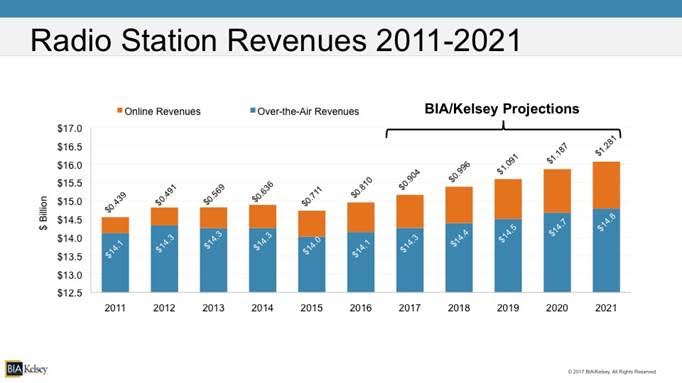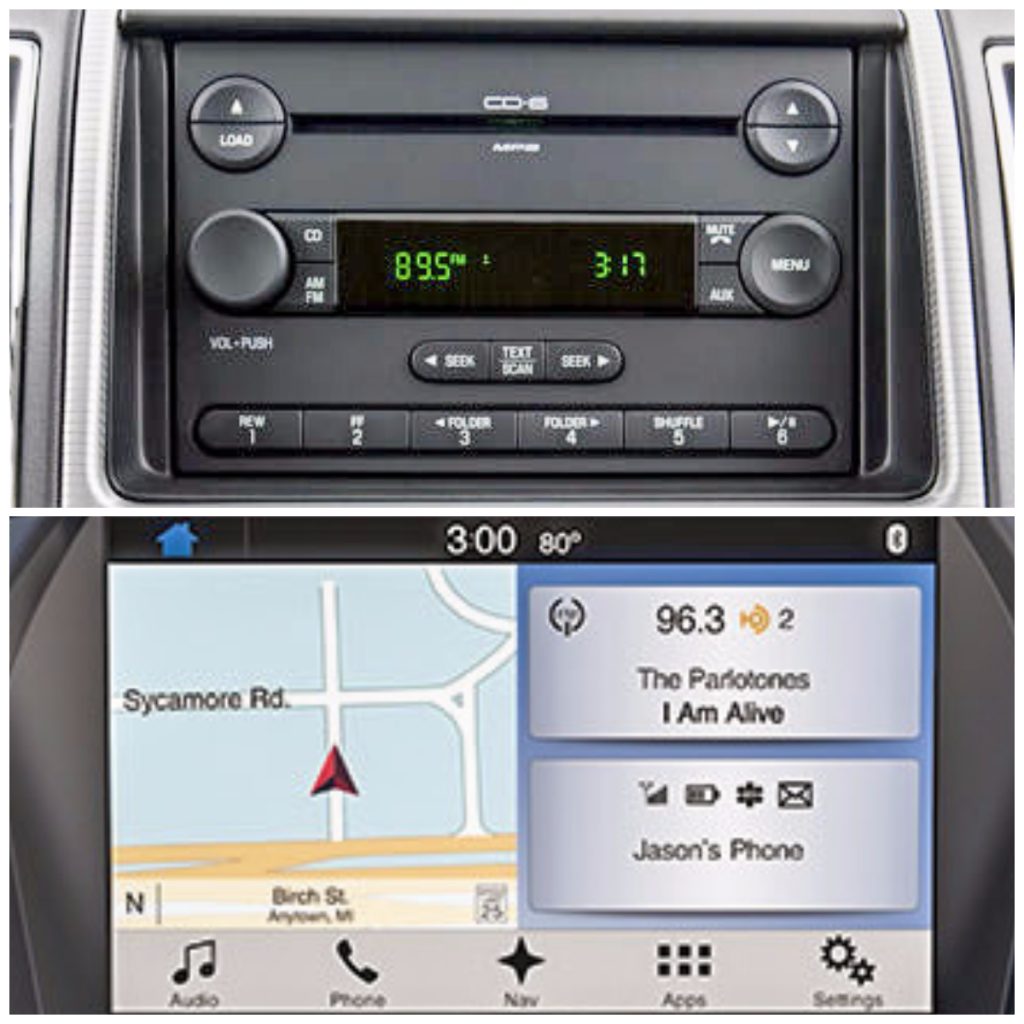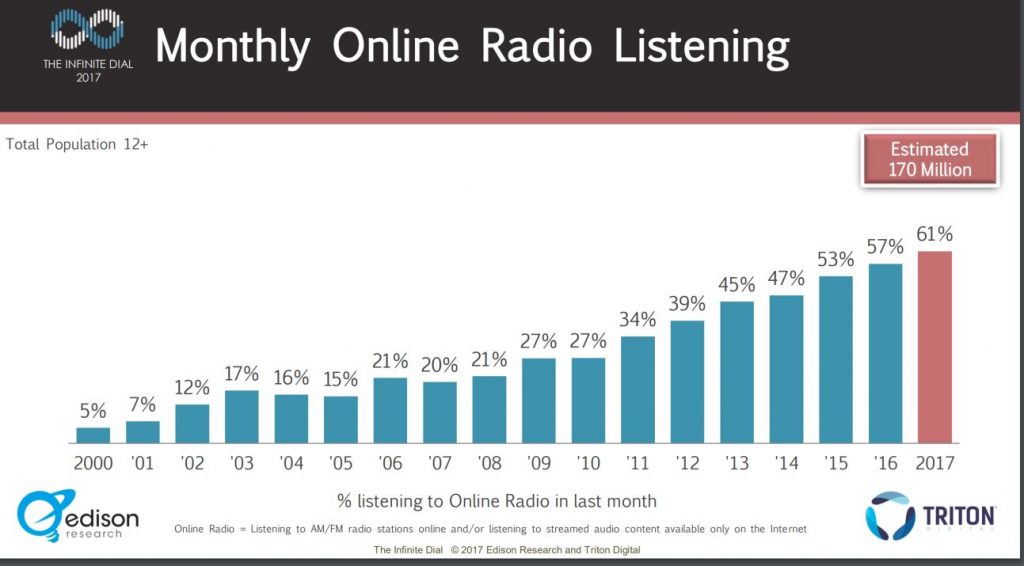Thoughts and perceptions on the state of the radio industry on the eve of the NAB Radio Show
I started my career in the radio business and had a great run before the industry began to go through a number of fundamental changes over the last decade or so. I’ll always cherish the memories of when radio was fun, exciting, and incredibly creative. Many of those aspects of the radio industry are gone, either because a station is owned by one of the small group of companies with huge debt issues or because a fairly healthy company has learned how to do business with fewer people doing more. But I’ll always have a soft space in my heart for radio. That’s why I was sad to see a report last week from Larry Miller at New York University titled “Paradigm Shift: Why Radio Must Adapt To The Rise Of Digital” .
You can read the report for yourself at the link above. There are some very important data points in regard to the lessening influence of broadcast radio on teens and young adults. If radio can’t capture teens, they won’t have them as listeners when they get older and start being targeted by advertisers. I found it fascinating how various publications and organizations, all with their own viewpoints on this matter, mostly formed well before the report came out, have chosen to share or try to debunk the findings of the report.
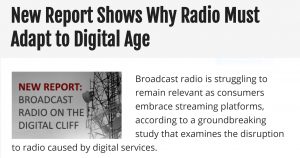 This is the way the site of the people who published the report, Musonomics, presented the piece. It’s a fairly unbiased summary showing what is in their report. The post gives some top-line findings and links to the full 30-page report, which is free to read should you be so inclined. Radio people who have read the report seem split on their level of agreement with what the document says.
This is the way the site of the people who published the report, Musonomics, presented the piece. It’s a fairly unbiased summary showing what is in their report. The post gives some top-line findings and links to the full 30-page report, which is free to read should you be so inclined. Radio people who have read the report seem split on their level of agreement with what the document says.
The wider media picked up on the report and it’s interesting to see how some more 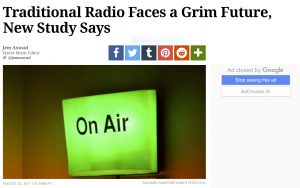 “mainstream” outlets “played” the story. Here’s how Variety looked at the report’s findings. You can click on the link above or on the screen grab of the story to see how a more mainstream entertainment publication that admittedly doesn’t cover radio very often spun the story. I’d consider it to be a decent take on the findings based on the amount of ink radio gets in that publication.
“mainstream” outlets “played” the story. Here’s how Variety looked at the report’s findings. You can click on the link above or on the screen grab of the story to see how a more mainstream entertainment publication that admittedly doesn’t cover radio very often spun the story. I’d consider it to be a decent take on the findings based on the amount of ink radio gets in that publication.
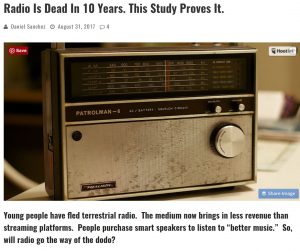 Then the digital music trades got their hands on the story. Of course, they want radio to go off the air tomorrow, so it makes sense that they would try to make this story seem to be the announcement that radio is over and done with. Digital Music News pulled no punches in their headline or the story itself. That isn’t unexpected, and it’s exactly what they would want their readers to see. I wonder how many of them noticed the radio in the picture is from Radio Shack, a company that is now dead.
Then the digital music trades got their hands on the story. Of course, they want radio to go off the air tomorrow, so it makes sense that they would try to make this story seem to be the announcement that radio is over and done with. Digital Music News pulled no punches in their headline or the story itself. That isn’t unexpected, and it’s exactly what they would want their readers to see. I wonder how many of them noticed the radio in the picture is from Radio Shack, a company that is now dead.
The radio trade press immediately ramped up their spin machines to discredit, dispute, and dissect the report. Inside Radio, a daily newsletter, wasted no time finding people to trash the report, including the National Association Of Broadcasters, whose executive vice president of communications, Dennis Wharton, issued an almost 900 word statement that can be found here. The statement did address the charge that radio’s billing is shrinking with this graph showing radio revenue over the last six years and projections through 2021. I feel compelled to point out that online revenues seem to be growing faster than broadcast revenues. Also, it is estimated that it will take until 2018 for the radio industry to equal the on-air revenue they generated in 2013 and 2014.
Perhaps the most potent salvo fired by the radio side in this argument was a blog post from the very bright Pierre Bouvard, the Chief Insights Officer at 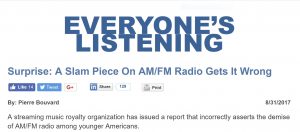 Cumulus/Westwood One, one of the three largest companies in the radio industry. The post is full of charts and graphs that (understandably) show how strong the radio industry is and trying to debunk just about everything in the study that started this brouhaha. Like the NAB’s Wharton, he minces no words in his opposition to the findings of the study and everything about it. If you can trust the data source, the much maligned Nielsen Portable People Meter used in 48 of the 268 Nielsen radio markets, there are some interesting arguments made in the post.
Cumulus/Westwood One, one of the three largest companies in the radio industry. The post is full of charts and graphs that (understandably) show how strong the radio industry is and trying to debunk just about everything in the study that started this brouhaha. Like the NAB’s Wharton, he minces no words in his opposition to the findings of the study and everything about it. If you can trust the data source, the much maligned Nielsen Portable People Meter used in 48 of the 268 Nielsen radio markets, there are some interesting arguments made in the post.
At this point, we need to hit the Reality Check button on three critical areas in the radio industry’s argument that the Larry Miller study is bogus.
First, radio no longer has an exclusive hold on what has been its most powerful delivery method, the automobile dashboard. As recently as ten years ago, most cars came standard with an AM/FM radio, usually with a CD or cassette player built in. Now, radio is just one of many choices sharing a touchscreen in the center of the dashboard, putting it on an equal playing field with everything from satellite radio to on-demand music services to podcasts, not to mention almost any app on a user’s smartphone. The image on top is a 2007 Ford radio. On the bottom is the screen of the Ford Sync system in their 2017 models.
Second, there’s no argument that more people are consuming audio online, whether it’s streaming audio from a radio app like iHeartRadio or a standalone streaming service like Spotify. Even the Nielsen radio ratings quoted in the Cumulus/Westwood One article above include broadcast AND online listening of stations who choose to add their on-air and online listening together for something they call Total Line Reporting. Edison Research’s Infinite Dial Study, considered the “gold standard” measurement of audio consumption, shows the growth of “online radio listening”, which basically means any real-time sound coming out of a speaker or headphones It also includes mobile devices, which continue to gobble up more and more online listening. So any live streaming of a radio station or listening to a music service stream is part of this chart, podcasts are not. And all of this data only shows listening, not revenue generated from that listening. The real revenue in audio is still with AM/FM broadcasting. We’re still some time away from making real money from streaming or satellite radio ads.
Finally, the crux of the Larry Miller study that so many in radio are trying to discredit. According to The Infinite Dial, there is a stark difference in both the amount of online “radio” listening and the growth of that listening among different demographic groups, and younger peoples’ listening is growing. The younger the group, the more audio they consume online. But almost a third of people 55+ are listening online as well. And since the number of hours in their days aren’t expanding that most likely means less listening to AM and FM.
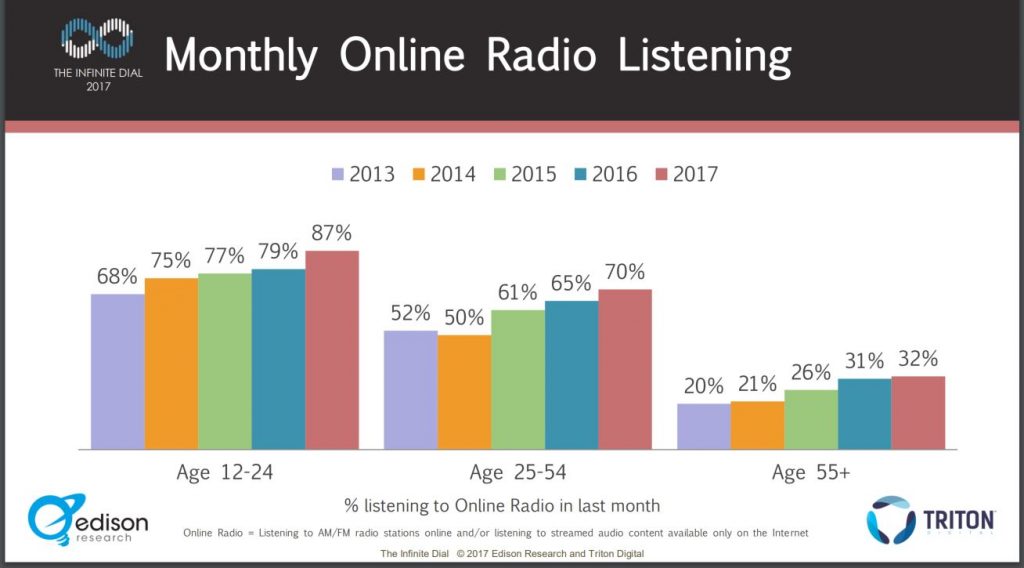 I realize I’ve presented a lot of data and opinion from both sides concerning the future of the radio industry. I also know this topic will be hotly debated at this week’s Radio Show in Austin. The event will probably include lots of consoling hugs at the S’mores And Storytime get together along with sessions like Get Your Digital Marketing In Shape Or Die! (sic) and an entire 45 minute session dedicated to The Ongoing Evolution Of Radio hosted by the guy whose company has been trying to get phone makers to put FM chips in their devices.
I realize I’ve presented a lot of data and opinion from both sides concerning the future of the radio industry. I also know this topic will be hotly debated at this week’s Radio Show in Austin. The event will probably include lots of consoling hugs at the S’mores And Storytime get together along with sessions like Get Your Digital Marketing In Shape Or Die! (sic) and an entire 45 minute session dedicated to The Ongoing Evolution Of Radio hosted by the guy whose company has been trying to get phone makers to put FM chips in their devices.
Without an intervention, and soon, this is what the future may bring. At this moment, over the air radio is headed for the same fate as the newspaper industry, with an overall decline but a group huge long-term success stories. Think of a lot of 24 page newspapers with very little local content and the New York Times and Washington Post. That’s the newspaper industry. Broadcast radio is on its way to being run by some good local owners, mainly in smaller markets and a handful of very large companies running centralized “command and control” operations that give local stations almost no say in their programming and puts revenue generation in any way possible as the Prime Directive. Then there will be a few, probably top twenty market, iconic stations that will still produce compelling content and generate a decent amount of money.
That fate can be avoided if the radio industry takes a deep breath, honestly admits to some of its problems, and takes real, meaningful, proactive steps to save itself so it doesn’t head into an aural version of the Dead Tree spiral. Here are some things the Big Kahunas, whether they be in Austin this week or in New York or Atlanta next week, need to acknowledge and act upon now before it’s too late.
Fix your online product Radio stations have been streaming online for well over a decade, yet the streams still have the same problem with not being able to seamlessly cover commercial pods, leading to horrific transitions in and out of breaks, and far worse, junk being put on the streams during those breaks. Just last night, I was listening to a show produced by a major network on the stream of a 50,000 watt AM station and I heard the same useless filler horoscope feature (where the announcer rattled off horoscopes at about 200 words per minute) three times in one break. There’s no excuse for that. In most cases, broadcasters know or can guess how long breaks will be, and they should invest in producing compelling filler content that complements the kind of show or music format being streamed. Yes, that will cost some money and take some planning but once your stream is no longer unlistenable, you’ll be able to show advertisers more listeners and longer listening sessions and you should be able to offset the cost of that online content creation.
Bite the bullet on interruptions I know that is a blasphemous comment, but radio is often playing a ridiculous number of commercials and they are sending listeners of all ages to online music services, Public Radio, or podcasts like rats off a sinking ship. To listeners, every interruption, whether its :60, :30, :15, :10 or a traffic report with a live spot is an interruption. Listeners don’t perceive the length of an interruption, so shorter spots that are supposed to generate fewer minutes of ads in an hour mean nothing to them when one stop set can have twenty units and elements in it. And this doesn’t apply only to music stations, the problem with interruptions exists in spoken word formats as well.
Prepare for the future because the future is NOW For some years now, the future in radio is often the next monthly or 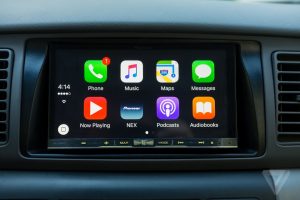 quarterly billing report. That’s fine for CFO’s, but not for the audience radio needs to court and hang onto. I’m not saying change formats to only things that appeal to Generation Z, I’m saying think about how people under 30 consume media and make radio accessible, interesting, and competitive with their other media choices. Yes, the station across the street is your competition, but so is everything on a screen that looks like this sitting where an AM/FM radio once sat.
quarterly billing report. That’s fine for CFO’s, but not for the audience radio needs to court and hang onto. I’m not saying change formats to only things that appeal to Generation Z, I’m saying think about how people under 30 consume media and make radio accessible, interesting, and competitive with their other media choices. Yes, the station across the street is your competition, but so is everything on a screen that looks like this sitting where an AM/FM radio once sat.
Radio people have been talking for decades about standing up to the challenges they face and winning the battles. It’s not happening, at least not enough to slow the growing dominance of online audio consumption. The time is now to admit how serious the situation is and find the people and resources to do something about it. If those hard conversations don’t start happening in Austin this week or in boardrooms soon, the industry will fall apart like a Robert Hall suit.
And that soft spot in my heart hurts because of that sad yet avoidable possibility.

